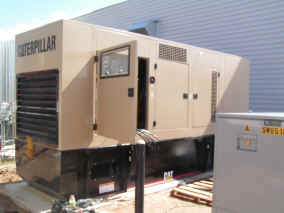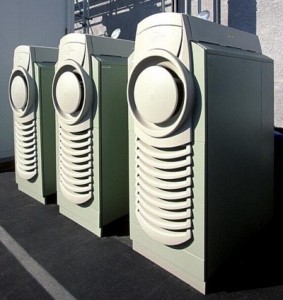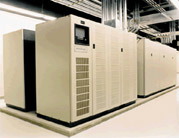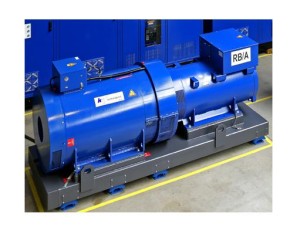Backup Power Systems
Emergency Power Systems
 Backup generators are the most well-known emergency power systems in use today. These systems run on diesel, gasoline, and natural gas sources depending on the function they serve and fuel availability. Although generator start-up time is short, it can take up to 30 seconds for a generator to reach proper engine speed for full-voltage output. In general, the shorter that time, the more expensive the system. To reduce system cost and keep mission-critical devices operating, we often combine a UPS with emergency generator systems to maintain power until the generator can take over. On-board UPS electronics are used to gradually reduce the UPS (battery) output based on the generator contribution.
Backup generators are the most well-known emergency power systems in use today. These systems run on diesel, gasoline, and natural gas sources depending on the function they serve and fuel availability. Although generator start-up time is short, it can take up to 30 seconds for a generator to reach proper engine speed for full-voltage output. In general, the shorter that time, the more expensive the system. To reduce system cost and keep mission-critical devices operating, we often combine a UPS with emergency generator systems to maintain power until the generator can take over. On-board UPS electronics are used to gradually reduce the UPS (battery) output based on the generator contribution.
Emergency generator systems can also be connected to a network to allow the system to be monitored from any location linked to the network. The level of sophistication and types of controls vary greatly between manufacturers and is usually reflected in the system cost.
 Many of your clients may even be interested in using generator systems for cogeneration, meaning that they can produce their own electricity and heat – the latter coming from heat-exchangers connected to the generator cooling system. Cogeneration is also used as a means to reduce or eliminate Hydro demand charges by providing power directly to the larger loads. To determine the feasibility of cogeneration, there are three basic conditions that the building needs to meet:
Many of your clients may even be interested in using generator systems for cogeneration, meaning that they can produce their own electricity and heat – the latter coming from heat-exchangers connected to the generator cooling system. Cogeneration is also used as a means to reduce or eliminate Hydro demand charges by providing power directly to the larger loads. To determine the feasibility of cogeneration, there are three basic conditions that the building needs to meet:
- requires both electricity and thermal energy (hot water, steam, space heat, etc) simultaneously;
- operates seven days a week, a minimum of 18 hours per day;
- consumes an average of 50kW of power and 200,000 BTUs of heat per hour
Items we specify in emergency generator system design include provision for generator battery charging, battery heaters, motorized intake and exhaust louvres, control panel instrumentation, and remote monitoring panel(s).
Uninterruptible Power Supply
UPS systems are commonly incorporated into many projects – a trend we anticipate will continue as power-quality problems increase. The prime role of a UPS is to provide a continuous and uninterrupted source of power to critical equipment until normal power resumes or until an emergency backup generator reaches operating speed. When specifying a UPS, it is crucial that it is properly sized. When specifying a system, we determine the volt-amp (VA) rating of the equipment to be protected, as well as the watts (w) it draws. This represents the electrical efficiency, or power factor of the equipment. A typical computer has a power factor of approximately 0.65 – meaning that only 65% of all the power it consumes is actually used to power the equipment. The remainder, or 35%, of the energy is wasted. The proper specification of a UPS depends on knowing how inefficient the mission-critical load is.
 A UPS contains integral filtering electronics and TVSS circuitry to help reduce line noise and power surges. The UPS utilizes battery cells to store power during normal power conditions, and an inverter to transform the DC battery power to AC power that’s required for equipment.
A UPS contains integral filtering electronics and TVSS circuitry to help reduce line noise and power surges. The UPS utilizes battery cells to store power during normal power conditions, and an inverter to transform the DC battery power to AC power that’s required for equipment.
Some UPS systems can be linked to a computer to provide continuous power-quality monitoring and to automatically log all events. An event is defined as a sag, surge, or total voltage loss. This computer link can be expanded to automatically shut-down computer systems in a safe manner – by closing application software so data is not lost.
We also ensure that the UPS is not under or over-sized because these systems are not as efficient in either of those extremes. Pro-EE Group can help your client to determine what future loads he needs to provide protection for. It should also be noted that UPS systems actually cause harmonic distortion on power lines – proper unit selection and the implementation of ancillary power conditioning is important.
Hybrid Generators and Flywheel UPS Systems
Flywheel technology has been applied to emergency power systems to eliminate the need for UPS/Generator combinations in certain applications.
 The hybrid generator combines a diesel engine coupled with a generator via a flywheel system that provides a means of inertial storage. The flywheel uses normal power to build up and maintain its speed. When normal power fails, the flywheel inertial momentum is used to spin the generator to provide power until the engine can take over. Hybrid systems don’t require banks of battery cells – saving large initial costs, space, and maintenance.
The hybrid generator combines a diesel engine coupled with a generator via a flywheel system that provides a means of inertial storage. The flywheel uses normal power to build up and maintain its speed. When normal power fails, the flywheel inertial momentum is used to spin the generator to provide power until the engine can take over. Hybrid systems don’t require banks of battery cells – saving large initial costs, space, and maintenance.
Flywheel UPS systems employ a flywheel and alternator to store inertial energy during normal power conditions, and to release it when emergency power is required. This is one of the true clean-source power systems developed for commercial applications and is competitive in cost to many traditional UPS systems.
